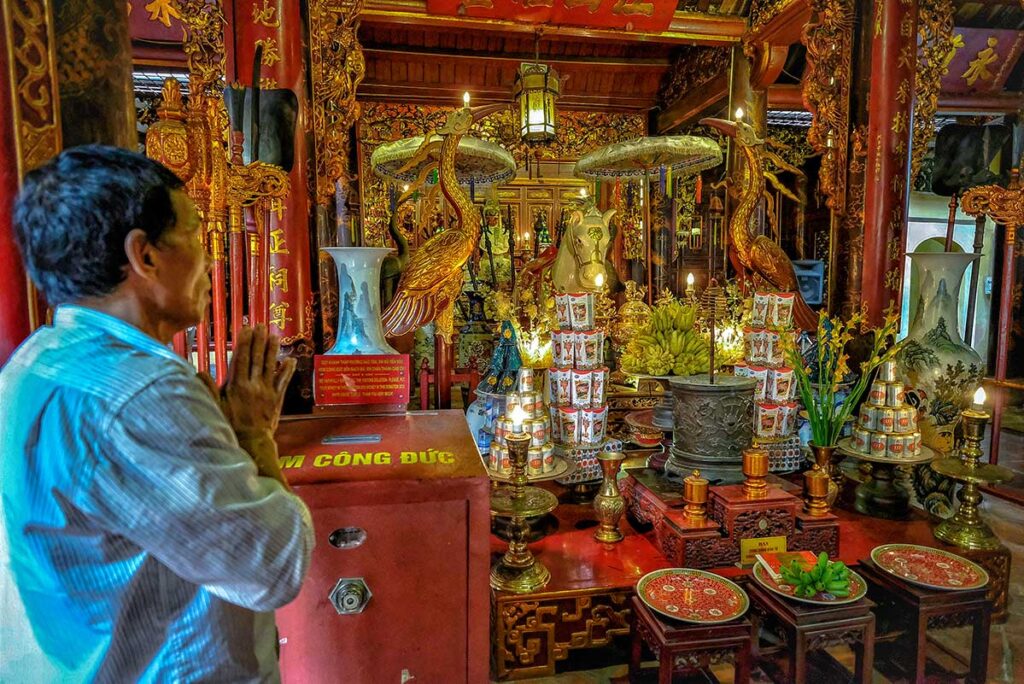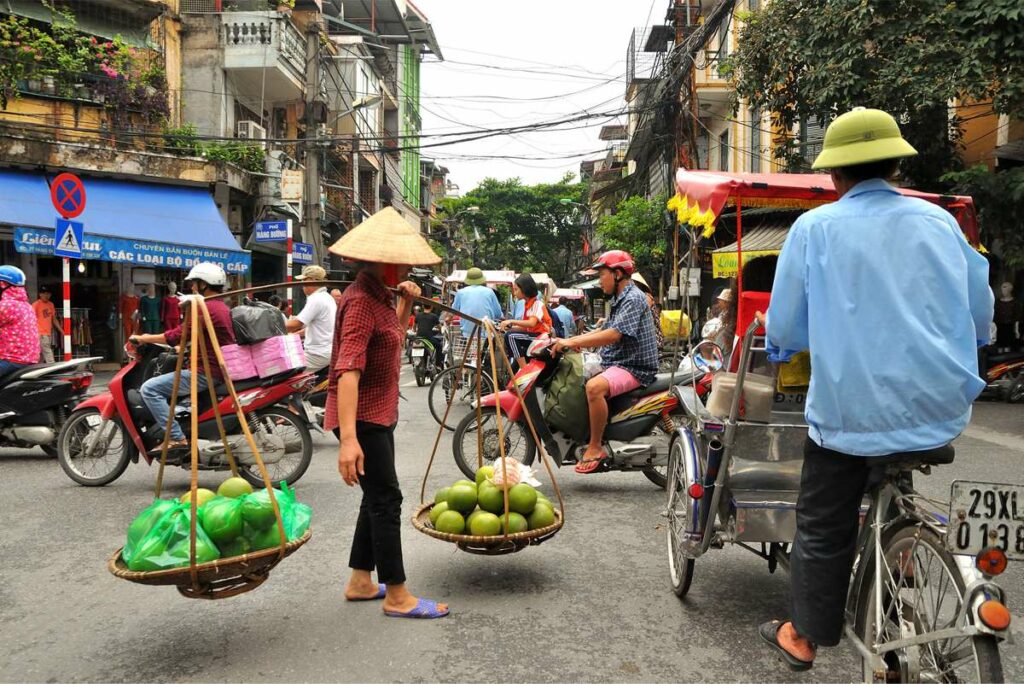What is Bach Ma Temple Like?
Bach Ma Temple is a small but atmospheric temple located at 76 Hang Buom Street, right in the middle of Hanoi’s busy Old Quarter. Its name, which means “White Horse Temple,” refers to a local legend involving a divine horse, but even without knowing the full story, the symbolism is clear from the striking white horse statue inside.
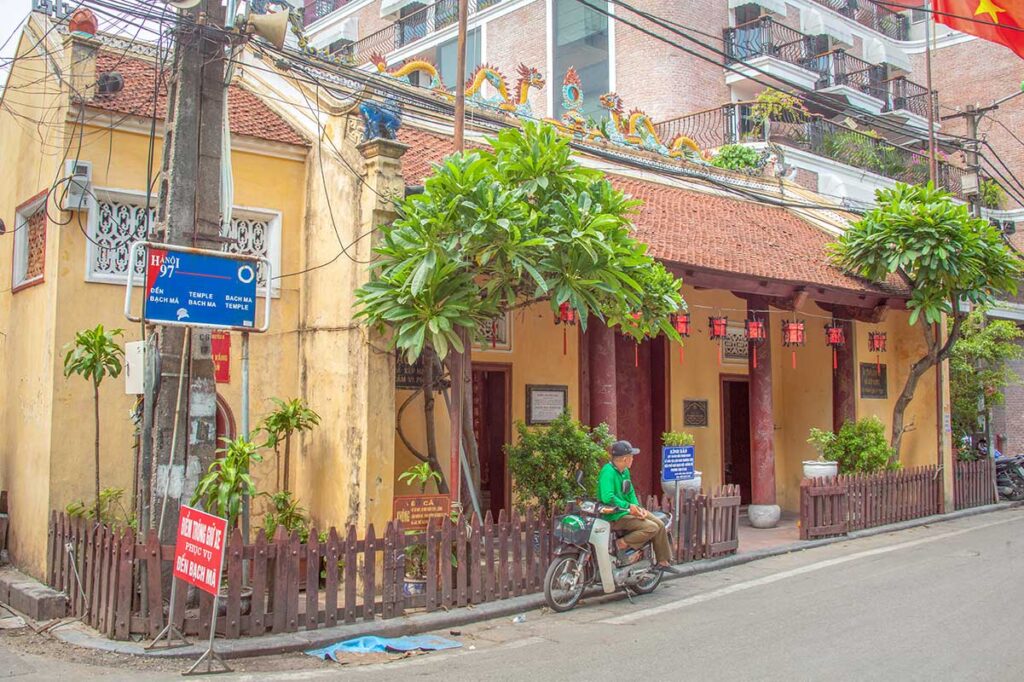
Despite being surrounded by narrow streets and constant activity, the temple offers a peaceful, spiritual pause — with incense curling through the air, soft lighting, and quiet worshipers creating a calm contrast to the city outside.
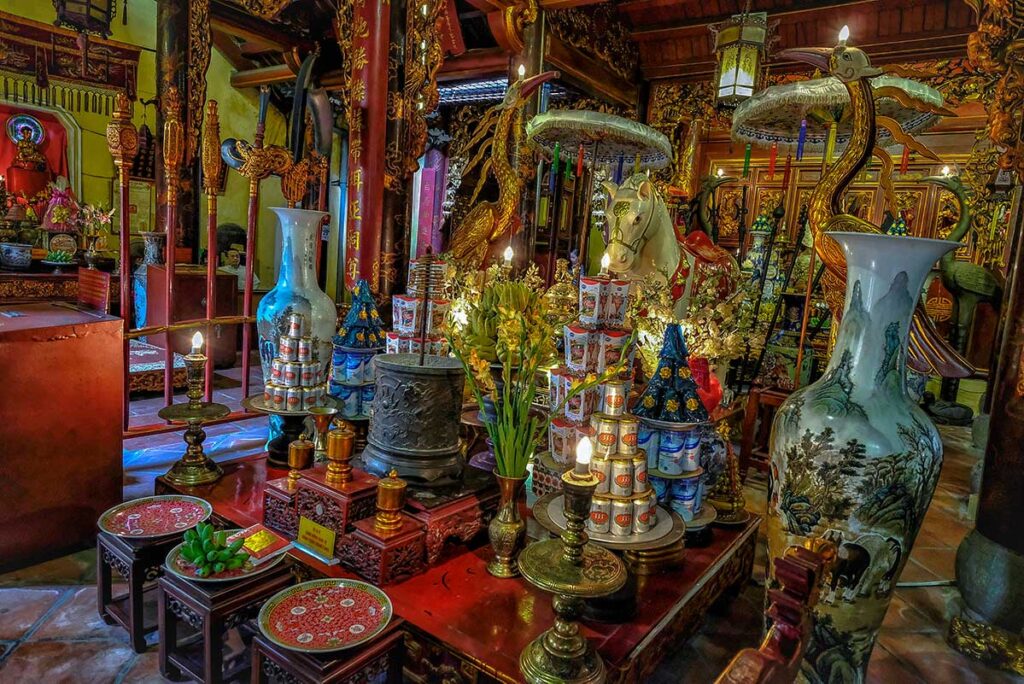
Bach Ma is often called the oldest temple in Hanoi, and while its origins date back to the 9th century, most of what you see today was rebuilt in later periods — especially during the 18th and 19th centuries. So while it may not be the oldest surviving structure, it’s still one of the city’s oldest places of worship and carries deep historical and spiritual weight.
History & Legend of Bach Ma Temple
Bach Ma Temple traces its origins back to the 9th century, when it was known as Long Do Temple and dedicated to the local guardian deity Long Do. In the 11th century, Emperor Ly Thai To rebuilt the temple after moving the capital from Hoa Lu to Thang Long (present-day Hanoi).
According to legend, when construction of the citadel walls kept collapsing, the emperor prayed at Long Do Temple and dreamed of a white horse emerging from the shrine. The horse ran through the area, leaving tracks that marked the path where the walls should be built — and when followed, the construction succeeded.
In honor of this divine sign, the emperor renamed the temple “Bach Ma,” meaning White Horse. Bach Ma later became one of Hanoi’s Four Sacred Temples, positioned in the east to protect the city’s spiritual boundaries, and was officially recognized as a national historical relic in 1986.
Highlights of visiting Bach Ma Temple
Despite its small size, Bach Ma Temple contains a number of details that make it worth a short visit. From architectural elements to religious symbols, the temple offers quiet but meaningful insights into Hanoi’s spiritual heritage.
1. The White Horse Statue
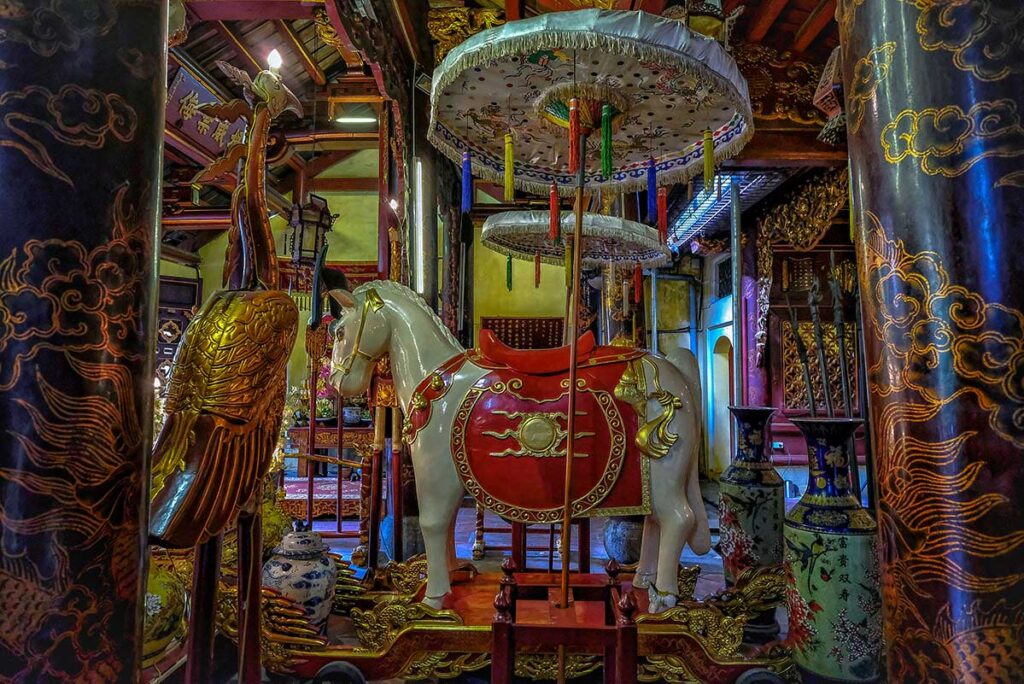
The white horse statue is the most iconic feature of the temple and directly tied to the legend behind its name. Representing divine guidance given to Emperor Ly Thai To, the statue stands prominently near the main altar and serves as a reminder of the temple’s origin story.
2. Red-Lacquered Palanquin
Near the entrance, you’ll find a striking red-lacquered funeral palanquin. Its ornate decoration and craftsmanship reflect traditional Vietnamese ceremonial art and offer one of the more visually impressive elements within the temple’s modest interior.
3. Co Ngu Hanh Flag (Five Elements Flag)
This colorful five-element flag symbolizes ancient Vietnamese cosmology, with red, yellow, green, white, and blue representing fire, earth, wood, metal, and water. The flag is often on display during festivals or important ritual dates.
4. Carved Wooden Architecture
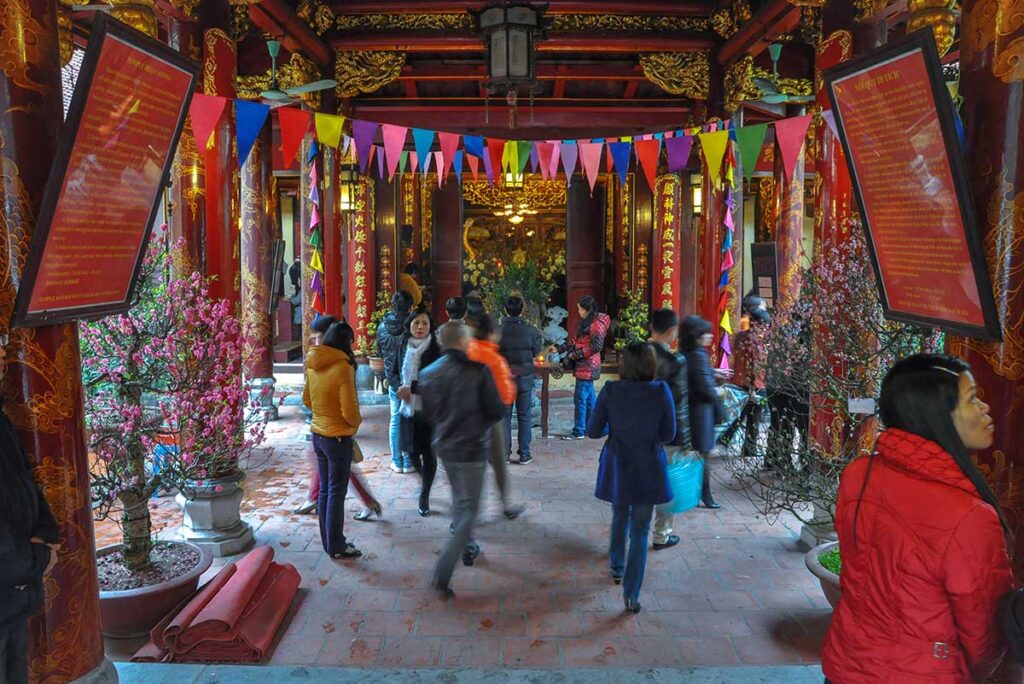
Though not grand in scale, the wooden structures of Bach Ma Temple are carefully crafted. The ironwood pillars, decorative beams, and antique wooden doors feature subtle carvings that show the preservation of Nguyen Dynasty design within the busy Old Quarter.
5. Worship Altars and Ceremonial Items
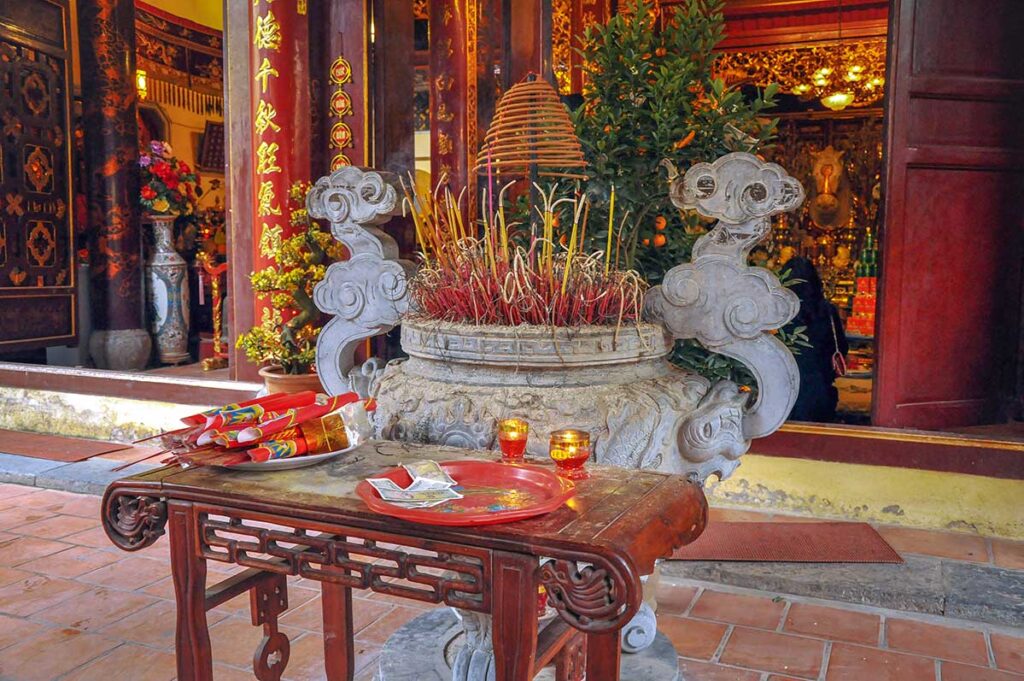
Inside the temple are multiple altars where locals quietly pray and leave offerings. Incense burners, ancestor tablets, ceremonial objects, and soft candlelight contribute to a tranquil and reflective atmosphere, even during brief visits.
Bach Ma Temple Festival
Each year, Bach Ma Temple comes to life during its traditional festival, held on the 12th and 13th days of the second lunar month — usually falling sometime in March, depending on the year. While most visitors miss this event due to timing, it remains a significant part of the temple’s cultural role in Hanoi. While most visitors miss this event due to timing, it remains a significant part of the temple’s cultural role in Hanoi.
On the first day, a procession featuring palanquin bearers, drummers, flag carriers, and dancers moves through the Old Quarter before returning to the temple. Sacrificial rituals are then performed to honor the deity. On the second day, more formal rites are conducted by elders, alongside traditional games and performances like tug of war, human chess, and folk singing.
For those in Hanoi during this period, the festival offers a rare chance to see local rituals in action — not staged for tourists, but deeply rooted in community tradition.
Practical visiting information
Entrance Fee
Free for all visitors — like most temples in Vietnam, there is no admission charge.
Opening Hours
Bach Ma Temple is typically open from 8:00 AM to 11:00 AM and again from 2:00 PM to 5:00 PM.
There are occasional variations depending on ceremonies or maintenance, so it’s safest to arrive before 4:30 PM if visiting in the afternoon.
Dress Code
While there is no strict enforcement, it’s best to dress modestly out of respect for the spiritual setting.
Shoulders and knees should ideally be covered. If you’re visiting on a hot day, consider bringing a light scarf or sarong to wrap around when entering.
Time Needed
Plan to spend about 15 to 20 minutes inside the temple.
It’s a short visit, but you can stay longer if you’re observing local worship or interested in the details of the architecture and altars.
Address & How to get there
- Address: 76 Hang Buom Street, Hoan Kiem District, Hanoi
- Location: In the heart of the Hanoi Old Quarter — surrounded by shops, cafes, and historic streets
You can walk to the temple easily if you’re staying in or near the Old Quarter.
From Hoan Kiem Lake, it’s about a 10-minute walk north via Hang Dao Street.
If coming from farther out, taxis and ride-hailing apps like Grab are the easiest options. No special parking is available nearby, so cars should drop off at the edge of the street.
Combining Bach Ma Temple with other sights
Thanks to its central location in the Old Quarter, Bach Ma Temple is easy to combine with other nearby attractions on foot. A short walking route can give you a well-rounded glimpse of Hanoi’s history, architecture, and daily life.
- Hanoi Historic Gate (O Quan Chuong) – Just a few minutes’ walk east of the temple, this is the last remaining city gate of ancient Thang Long and a great photo stop.
- Hoan Kiem Lake – About a 10-minute walk south, the lake is one of Hanoi’s most famous landmarks and a popular place to stroll or relax.
- Ngoc Son Temple – Located on an island in Hoan Kiem Lake and accessed by the iconic red bridge, this temple is another spiritual site worth visiting.
- St. Joseph Cathedral – A short walk west of the lake, this neo-Gothic church adds a very different architectural flavor to your Hanoi walk.
For more inspiration and nearby ideas, check out our full guide to the Best things to do in Hanoi Old Quarter.
Is Bach Ma Temple worth visiting?
Yes — especially if you’re already exploring the Old Quarter. Bach Ma Temple isn’t large or visually dramatic, but its historical depth, peaceful atmosphere, and unique legend make it a meaningful stop. It’s not a destination you’d cross the city for on its own, but as a short cultural visit within a walking route, it’s absolutely worth your time. Ideal for travelers curious about Hanoi’s spiritual roots, local traditions, or lesser-known landmarks that still carry real significance.
